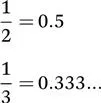1.1 The History of Numbers
The first humans presumably had no need for numbers and would therefore probably not have understood the concept. Eventually, of course, numbers were invented for use in counting … taking stock of animals and items of trade. The first set of numbers was undoubtedly simply a set of integers beginning at 1 and increasing from there … we are all familiar with them as we learn them at a very early age. This is very obvious and intuitive to us; anyone that counts uses these numbers. It turned out, however, that this number system was to be altered to include zero. Why? It was originally used as a placeholder for larger numbers. Thus, in the number 1053, the zero is in the “hundreds” column and indicates that are no hundreds to be added into the number. It consists of 3 ones, 5 tens, 0 hundreds and 1 thousands. Used at first in India for practical calculations it was imported into ancient Babylonian mathematics to replace a cumbersome placeholder system of slanted wedges. Its use was only as a placeholder and as it was not used alone it was not really considered to be a number. It did, however, come to be used as a number and it is now an integral part of our number systems. So, the simple number system was altered out of necessity to produce what we now refer to as the natural numbers.
Negative numbers were introduced to represent debts, again in India and again the number system was altered to include negative numbers into what we now refer to as the integers. There were those in ancient Greece who considered negative solutions to equations to be false and “absurd” so the use of negative numbers has not been without its critics.
Next, in order to express fractional quantities another set of numbers was needed. Using fractions of integers we come up with the rational numbers. Thus:
but we still do not have a complete set of numbers. The Greek Pythagoreans considered the integers to be “perfect”. Since the rational numbers are expressible using integers, they too were considered to be perfect. However, for them, a major problem existed, ironically from the results of what we now call the Pythagorean theory. The theory says the sum of the squares of the two sides of a right-angle triangle is equal to the square of the hypotenuse and has been proven many times in many different ways. If the two sides are each one unit in length then the length of the hypotenuse must be equal to the square root of two. The square root of two cannot be expressed as a ratio of integers which made the Pythagoreans very uncomfortable since it could not be constructed from “perfect numbers”. It is now referred to as an irrational number. Another example of an irrational number is π. So yet again, the number set was added to with rational and irrational numbers. Together they make up the set of real numbers.

